#estrildid finch
Text

April 30, 2024 - Fiji Parrotfinch (Erythrura pealii)
Found only in Fiji, these estrildid finches live at the edges of forests and in gardens and suburban areas. They mostly eat grass seeds, along with some insects, spiders, and sometimes berries and nectar, often foraging on the ground in flocks. Probably breeding from January to April and July to August, they build domed grass nests with side entrances in trees. Females lay clutches of four, or sometimes three, eggs.
58 notes
·
View notes
Text
BOTD: Red Avadavat

Photo: Hari K Patibanda
"Strikingly pretty small finch. Males are largely red and covered in white spots with dark wings and tail. Females are gray with a rufous rump. Both sexes have a red beak. Gives a very musical song a high 'teei' call. Found in grassy areas close to water and often near human habitation, particularly areas with wet rice paddies."
- eBird
#native to asia but introduced in a few places to the americas!#birds#red avadavat#birds of north america#north american birds#strawberry finch#strawberry munia#red munia#finches#estrildid finches#munias#passerines#birds of the us#birds of the caribbean#birding#bird watching#birdblr#birblr#bird of the day#Amandava amandava
108 notes
·
View notes
Text

I don't typically share works-in-progress here, I tend to only post finished artwork on tumblr. Would you guys be interested in seeing my art in its early stages? The project I'm working on right now isn't likely to be ready for release until early next year, but do you like seeing previews? Let me know!
Featuring: this Orange-cheeked Waxbill I started yesterday.
#birdblr#waxbill#songbird#wildlife#finches#estrildid#asian birds#scientific illustration#ornithology#artists on tumblr#work in progress
250 notes
·
View notes
Text
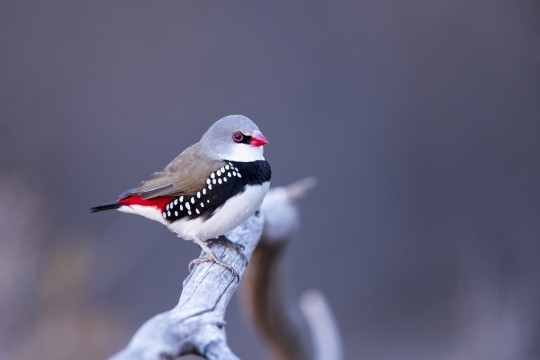
[2955/11080] Diamond firetail - Stagonopleura guttata
Order: Passeriformes
Suborder: Passeri
Superfamily: Passeroidea
Family: Estrildidae (estrildid finches)
Photo credit: Laurie Ross via Macaulay Library
#birds#Diamond firetail#Passeriformes#Passeri#Passeroidea#Estrildidae#Stagonopleura#birds a to z#undescribed#25% - 50%
367 notes
·
View notes
Text
Bird Symbolism in Revolutionary Girl Utena
There is quite a large amount of bird and bird-related imagery, symbolism, allegories and metaphors in Revolutionary Girl Utena, and i think all of them are very interesting. Here is a ~2000 word essay about the topic.
The Birdcage Garden: Anthy and Ohtori Academy

This is perhaps the most obvious of the bird symbols in Utena. It is literally Anthy's cage. It is where she, as the Rose Bride, is supposed to spend her time watering the flowers. Touga talks about never letting her out of it once he wins her, and calls her a "lovely little bird." And doesn't that just sum up what so many people's idealized version of her is like? A pretty thing to be admired, only in captivity.
I think the birdcage can also be seen as a sort of microcosm of Ohtori Academy as a whole. Akio does call the school "a garden where people will never become adults," after all, and Anthy is not the only person trapped there, nor is she the only character associated with birds.
According to this analysis, "Ohtori" as a word can mean "big bird" in japanese, and is also a Japanese term for the Fenghuang bird in Chinese mythology, said to be "beautiful, immortal and rules over all birds." Sounds a lot like a certain someone in charge of this place, doesn't it? Which would make every person in Ohtori a bird, symbolically speaking, trapped in the cage that is the academy and ruled by Akio (who, despite being the biggest, and the one with the most control, is also a caged bird.)

Additionally, the statue on the gate to the dueling arena is in the shape of a bird, before it transforms into a rose when opened. I am not sure exactly what this means, but I assume it is in some way symbolic of Akio, Anthy and Ohtori.
The Bird and the Window: Shiori and Juri

The bird that flies into the window during Shiori and Juri's conversation in episode 17 is a Java Sparrow. Despite its name, it is a part of the Estrildid Finch family, but I think the symbolism for sparrows fits the context more, as they can represent love, devotion and compainionship, all of which are very relevant for Juri and Shiori.
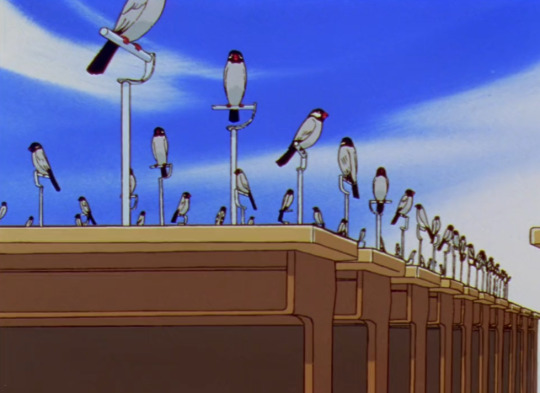
The bird is also the symbolic item for Shiori's black rose duel, which means we should associate the bird mainly with her. What, exactly, is the window, then? I think it is symbolic of Shiori's feelings for Juri, Juri's feelings for Shiori, or most likely both. The bird hits the window directly after Juri says "Is that all you have to say to me?" and turns to leave. The bird hits something it could not see in its flight, just as Shiori hits against something that hurts her, even if she doesn't understand it, in her conversation with Juri. The bird is shown to be lying still, presumably dead, after Juri reveals that she was never in love with the boy Shiori "stole" from her.
The bird is shown again after Juri throws her locket in the lake, and before Shiori finds it in her dorm. I've heard it discussed that this implies the bird retrieved the locket (probably through Anthy-as-Mamiya), and if the bird is symbolic of Shiori and the locket is symbolic of Juri's feelings for her, it would mean Shiori is the one to bring them back after Juri tries to rid herself of them. This makes sense.
The Bird Nest: Kozue and Miki
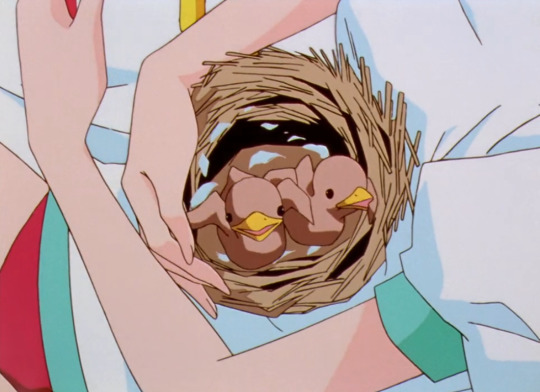
The bird nest that Kozue rescues from the tree that is going to be cut down is symbolic of her and Miki. Or, at least they are symbolic of how Kozue views the two of them. The comparison is pretty straightforward; Kozue projects her and Miki's feelings of abandonment onto these baby chicks, who have been left behind by their parents, just like the two of them were when their parents divorced. I think she projects her protectiveness over her brother moreso than her own feelings about the whole thing, as Kozue likes to think of herself as very independent ("a wild animal") and very unaffected by it all. As seen by her attempt to save the birds in the first place, she is very willing to put herself at risk, and is less concerned with her own feelings/safety.
Now, I don't want to get too much into speculation, but I have to wonder if there was more going on in the Kaoru family than just the divorce and the too-high expectations for the "twin prodigies." Miki's uncharacteristic cynicism in saying "adults who tell you something is for your own good can never be trusted," as well as Kozue's total disregard for authority and her tendency to use her sexuality as a tool both concern me. Although Miki and Kozue's parents are not explicitly shown to be abusive, I do not think it is a stretch to say that there is a possibility that they were. It explains some of Kozue's behaviour in regards to Miki as well. It's not just posesiveness but protectiveness. She has needed to protect him before, and she feels she needs to protect him still (pushing the predatory teacher down the stairs, saving the birds she sees his innocence in.)
Interestingly enough, Anthy interacts with these chicks as well. She advices Miki on how to feed and take care of them. Utena even comments on how unusually straight forward she's being about the whole thing. This might just be another instance of characterizing Anthy as a person who is fond of animals, and that is certainly part of it, but i think there is more to it as well. If these baby birds are symbolic of (Miki and Kozue's, but also a general) feeling of abandonment by parents/adults, as well as their potential abuse, what does that mean for Anthy not only knowing how to take care of them, but being eager to talk about it? Could it perhaps be that she, like Kozue, sees herself in them? Like Kozue, Anthy herself is symbolically a bird, but a caged one in contrast to Kozue's claims of being a wild animal. Could it be that Anthy has had to become an expert in taking care of those (herself) that have been abandoned or failed or abused by the adults in their lives? Rememeber that this is the same episode where she says that Akio is more like a father to her than a brother. A parallel is indirectly being drawn between him and the Kaoru parents.
If Miki and Kozue's parents were abusive, this might be a rare moment of Anthy empathising with other victims, telling them through metaphor how to take care of themselves. Although, it doesn't keep her from continuing to manipulate them, as she goes on to say her line about returning the chicks to their mother, which is what sets Kozue off. Anthy also says that she's never actually raised chicks before. Maybe she's not very good at taking care of them (herself) after all.
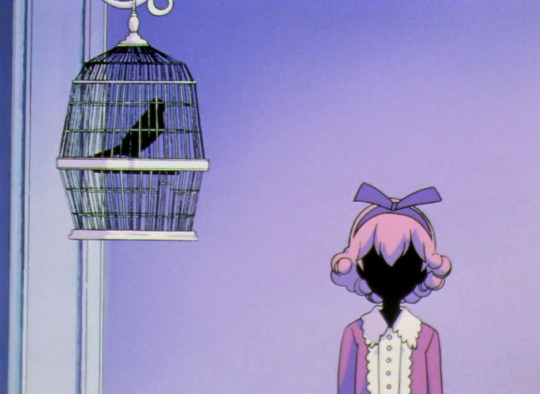
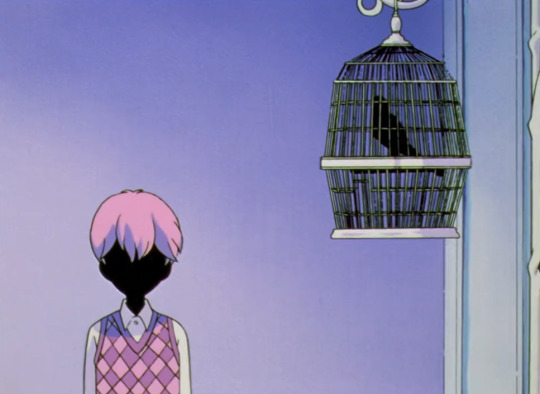
There's also what looks like two caged parakeets in Miki's flashback of their childhood. I assume this has similar meaning to Anthy's birdcage, as a feeling of being trapped, in this case by their parents' expectations for them. Kozue used to be a caged bird, but now claims to be a wild one, despite still being inside the birdcage that is Ohtori.
Brood Parasitism: Nanami and Touga (and Utena)
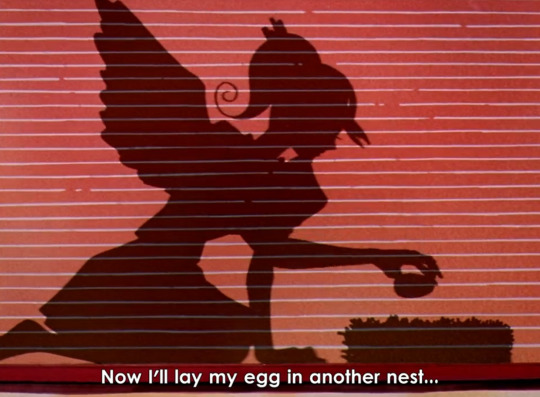
The Kaoru's are not the only sibling pair in Utena to be compared to birds. In Episode 31, Her Tragedy, a pretty unique shadow play is put on in the Chairman's Tower about a cuckoo leaving its egg in another bird's nest, a phenomenon known as brood parasitism. It also references the fairy tale The Ugly Duckling by Hans Christian Andersen. Perhaps the most interesting part of this play is that it's done in the style of the ones in the black rose arc, with C-Ko playing all the roles, the return of the monkey-catching robot, and Utena's fourth-wall breaking commentary at the end. I won't get into what this means, as it doesn't have anything to do with the bird metaphor, but maybe in another post.
This shadow play is about how Nanami and Touga were adopted, and specifically about Nanami's feelings on the matter. Of course adopted children are not parasites, but it makes sense for Nanami to think along those lines, considering her fear of being compared to animals or aliens, and of being ostracized by the society she lives in. Nanami doesn't actually know that she is adopted, only that Touga is, which muddies that interpretation a little. Perhaps it is about Nanami blaming Touga's birth parents for "leaving him in another nest"? Something about her resentment of Touga at this point in time, thinking of him as a parasite in their family? Or simply her fear of what not being his blood-relative means.
I'm more confident about the Ugly Duckling reference, and it being symbolic of Nanami's worry of not fitting in among her peers. Nanami mainly copes with this by thinking that the reason she doesn't fit in, is because she is actually better than everybody else, because she's related to Touga (being a beautiful swan among the common ducks.) The play ends with the cuckoo insisting that it will become a swan one day, when really it can't. It will never be a duck that fits in, either. It will always just be what it is, a parasite (a space-alien. A girl who lays eggs.) This reflects Nanami's despair at the idea that she's "just another fly in the swarm" after her duel in the next episode.
And like all the shadow plays this one can be interpreted as being about Utena as well. She is an orphan who is now being raised in Akio and Anthy's "nest". Although she wasn't placed there by anyone but Akio himself, so it's more about her insecurities about feeling like an outsider in their family. And like the Ugly Duckling/cuckoo, she is also out of place among the rest of the students, and dreams of growing up to be something she can't actually become, in this case a prince. (credits to this analysis on the shadow plays for helping me piece together my thoughts on that. Always cite your sources!)
Cuckoos can also be symbolic of one-sided love, and is the origin of the word cuckoldry. Make of that what you will.

I should mention that Nanami also lays an egg of her own a few episodes prior. ...Or does she?
Her nightmare sequences show her fears of being compared to a chicken, a turtle, a frog, and of course, a space alien, but it is quite obviously a bird egg. And since we are later shown that Anthy has a chicken named Nanami, much like the cow with the same name, it can be assumed that the egg comes from there, and that Anthy brought it to Nanami's bed, perhaps via Chu-Chu. Could this relate to the brood parasitism of the cuckoo in some way? Is this not one bird (Anthy) laying its egg in another bird's (Nanami's) nest (bed) and getting them to raise it? is this what Anthy means when she tells Miki she has never personally raised chicks? Are all of these metaphors connected??? There's also the fan-theory that Nanami's egg hatched a reincarnated Chu-Chu, and in that case would he be the baby cuckoo while Anthy is the mother and Nanami is the duck? I'll be honest I'm not really sure what to make of it at this point. Draw whatever conclusion you want!
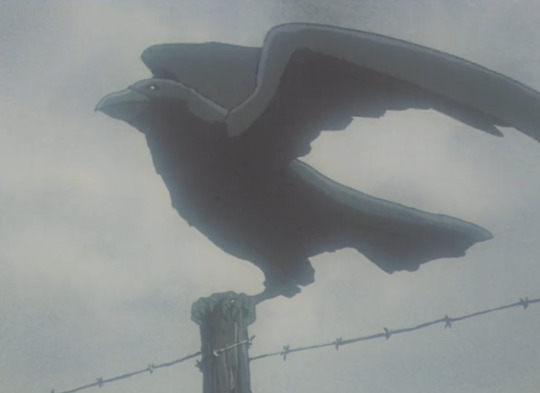
Last and probably least interesting is the third of Nanami associated bird imagery: the crow in episode 10. Crows can be symbolic of death, and it feels safe to say that this one is just here to set the mood of the scene, and as visual confirmation that the kitten did indeed die. Not too much to say there.
The Chicken and the Egg: The Student Council
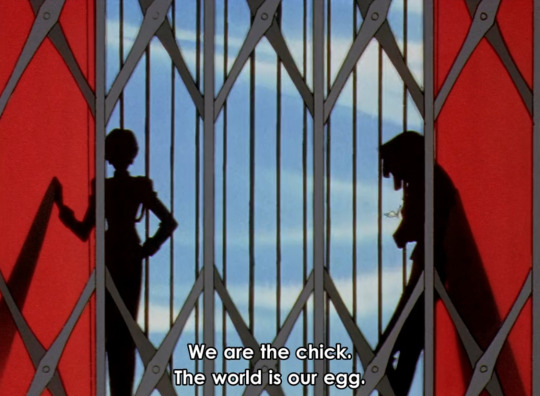
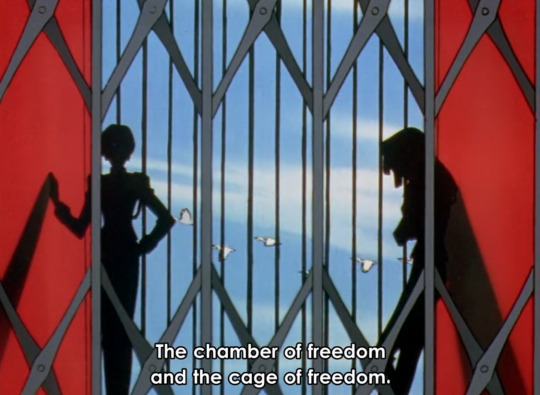
I'd be remiss if i didn't mention the student council's chicken and egg speech in this post as well, even if it has been analyzed to hell and back by hundreds of people before me. It is a reference to Hermann Hesse's book Demian. It is about breaking out of childhood and into adulthood. It is about escaping Ohtori, which is both the egg and the cage (and interestingly enough, during the speech birds can be seen flying by outside the cage of the elevator.) In Nanami's version of the egg speech she mentions "the cage of freedom" and how it cares for the chick. This something that ideally should be true for schools. A place that limits children, but in a way that prepares them for the adult world. Of course, Ohtori as a system has no interest in this, as it is a cage in its most literal sense: a place to keep people trapped. Trapped in their harmful behaviours, in their lack of growth, in their idealized memories of the past, and most of all, in childhood.
And with that, we have come full circle back to Anthy's birdcage as a symbol for all of Ohtori. Thanks for reading :)
#it's done! my first proper analysis-essay since my very first post on this account!!#i know it's long but i put a lot of work into this and i'd really appreciate if you read it ^_^#although i'm not entirely satisfied with the juri/shiori segment. if anyone has anything to add i'd love that#revolutionary girl utena#analysis#anthy#akio#shiori#juri#kozue#miki#nanami#touga#utena#m#animal motif#kaoru siblings#kiryuu siblings
303 notes
·
View notes
Text

Red-cheeked cordon bleu 💙🐦 😊
(Photographed in Nairobi, Kenya)
The red-cheeked cordon-bleu or red-cheeked cordonbleu (Uraeginthus bengalus) is a small passerine bird in the family Estrildidae. This estrildid finch is a resident breeding bird in drier regions of tropical Sub-Saharan Africa.
Photo by:@philipps.world.of.photography
132 notes
·
View notes
Note
i dont have an estrildid finch for you tyet but yoi Remind me of a seagull
Really now?
I do not know if I should be flattered.
Well, I do spend my time at the dock, on my ship, sometimes eating left overs, smelling like the sea, and...
... What are you going to do with the passerine? And how, why do you are yet to have it for me?
#lego city adventures#lca#lca captain facepatch#captain facepatch#ooc: What you gonna do to the bird
2 notes
·
View notes
Note
estrildid finch assigning you you are so a zebra finch theres no other person that could zebra finch more than you
Ooh, a zebra finch! Quick fact for those who don't know, they're one of the fastest maturing bird species recorded! Young zebra finches are ready to start mating at the age of just 80 days! Fascinating, really!
2 notes
·
View notes
Note
its onligatory i wayever the other word for kin but with bird assign yuo an estrildid finch. i think maybe yuod be tge generic female zebra finch but thats too generic so Porbably a diamond firetail. WHICH MEANS I Havw to go give tippy a different finch
Oh! I've heard about you, bird anon. Duke said something about someone coming in to assign me one of these, I've been waiting. Thanks for the assign, the bird looks awesome. And really captures kaboomin with that name 💥💥💥
- 🧨
2 notes
·
View notes
Note
i think if yuo were an estrildid finch yuo would be a diamond firetail
Just looked them up and I agree
4 notes
·
View notes
Note
if yuo were an estrildid finch id probablu have to give you like. lavender waxbill or a cordon bleu. ots a hard descicison since i cant reallu find any finches that woild fit yuo but also Maybe Perhaps a shaft tailed finch. not an estrildid finch but also maybe a canary
Your finches are safe in their enclosure, well fed and happy
1 note
·
View note
Text

February 14, 2024 - Red-winged Pytilia (Pytilia phoenicoptera)
Found in a patchy range across central Africa, these waxbills live in savannas, shrublands, and grasslands. Foraging mostly on the ground alone or in pairs and sometimes joining mixed-species flocks, they feed on grass seeds and termites. They build ball-shaped nests with side entrances in bushes from grass stems and seed heads, lined with feathers and dry grass. Females usually lay clutches of three or four eggs.
#red-winged pytilia#waxbill#estrildid finch#pytilia phoenicoptera#bird#birds#illustration#art#grassland#birblr art
62 notes
·
View notes
Text
BOTD: Java Sparrow

Photo: J. N. Stuart
"A small, plump finch with a very thick pink bill. The black head and white cheek patch are distinctive. Juveniles have a similar color pattern but are grayer. Social; forages in flocks and roosts communally. Forages in rice fields, grasslands, meadows, and urban and suburban areas (in introduced range). Call consists of one or more musical chirps. Native to the Indonesian islands of Java and Bali, where now quite rare. Introduced widely across the globe including India, Philippines, Venezuela, Puerto Rico, and the Hawaiian Islands."
- eBird
#birds#java sparrow#birds of north america#north american birds#finches#estrildid finches#passerines#birds of the caribbean#birding#bird watching#birdblr#birblr#bird of the day#Padda oryzivora
57 notes
·
View notes
Photo

The tricoloured munia is an estrildid finch, native to Bangladesh, India, Sri Lanka, Pakistan, and southern China. The species has also introduced to the Caribbean, in Trinidad, Jamaica, Hispaniola, Puerto Rico, Cuba, and Venezuela. This species, like the chestnut munia has been known as the black-headed munia❤️ 🌟📸 By @prasannag_clicks 🌟 Follow and support the photographer. Selected by : @soulandfuel 🎆Congrats for the feature🎆 ▶️Follow & use #birdphotographyworld to get featured on our page◀️ Image is a copyright of the photographer (at Dombivli) https://www.instagram.com/p/CpnKZyjPJQ5/?igshid=NGJjMDIxMWI=
0 notes
Text

[2989/11080] Double-barred finch - Stizoptera bichenovii
Order: Passeriformes
Suborder: Passeri
Superfamily: Passeroidea
Family: Estrildidae (estrildid finches)
Photo credit: B Jenkins via Macaulay Library
#birds#Double-barred finch#Passeriformes#Passeri#Passeroidea#Estrildidae#Stizoptera#birds a to z#undescribed#25% - 50%
189 notes
·
View notes
Text
Fwd: Graduate position: CharlesU_Prague.ProgrammedDNAElimination
Begin forwarded message:
> From: [email protected]
> Subject: Graduate position: CharlesU_Prague.ProgrammedDNAElimination
> Date: 7 March 2023 at 05:16:19 GMT
> To: [email protected]
>
>
>
> PhD position in: Mechanisms of programmed DNA elimination in songbirds
> Application deadline extended until: March 15th, 2023
> Position is for 4 years and starts in October 2023
>
> Multicellular organisms usually have the same genetic information in all
> cells of an individual. There is, however, a growing list of exceptions,
> where parts of the genome are removed from some cells. This programmed
> DNA elimination has evolved multiple times across animals and plants,
> but we still know very little about its function, proximate mechanisms,
> and evolutionary significance. This project aims to study programmed
> DNA elimination in songbirds, where a whole chromosome is removed from
> the somatic cells during embryogenesis and from the male germ cells
> during spermatogenesis. This germline-restricted chromosome (GRC) shows
> extraordinarily dynamic evolution and unstable meiotic and mitotic
> inheritance. Yet, it has not been lost from the genome for over 30
> million years of songbird evolution, suggesting that it has an important
> function. The goal of this project is to reveal cellular mechanisms of
> the GRC elimination from the somatic cells as well as from male germ
> cells and clarify modes of GRC inheritance. This will be achieved using
> a combination of advanced cytogenetic, immunohistological and genomic
> approaches. The project will be performed on two model organisms,
> the two closely related nightingale species of the genus Luscinia and
> several estrildid finches of the genus Lonchura. The successful candidate
> will have the opportunity to work in an interdisciplinary team of young
> researchers experienced in cytogenetics, genomics and bioinformatics.
>
> Where we are based:
> Our group is based at the Department of Zoology, Faculty of Science,
> Charles University, which belongs to the leading research institutions
> in the Czech Republic. The Faculty of Science is situated in the center
> of Prague, one of the world's most beautiful and monumental cities.
>
> How to apply:
> If interested, please, send (1) CV, (2) motivation letter and (3) contact
> details for 2 references to Radka Reifova ([email protected])
> by 15th March 2023.
>
> Contact: Radka Reifov�, Department of Zoology
> ([email protected]). Web page:https://ift.tt/4uFncDt
>
>
> Radka Reifov�
0 notes